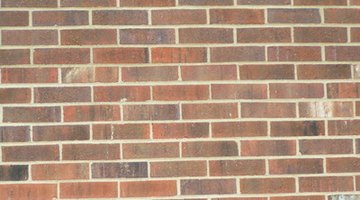What are the Problems With Brick Veneer on the Outside of a House?
Brick veneer is a common exterior surface on contemporary houses and is a particular favorite on ranch houses and bungalows from the 1960s and 1970s. While houses clad in brick veneer are sometimes indistinguishable from solid brick houses when viewed from the outside, their composition is quite different.

Brick houses are usually built with walls several bricks thick, and the bricks are the structural support of the house. Brick veneer is applied on the outside of preexisting walls and serves no structural purpose.
Water Leakage
If brick veneer is not properly installed, or, if over time it develops cracks or openings, water can enter in between the bricks. Because most brick veneer is installed on the outside of a wood framed house, the water can become trapped between the brick and the wood of the house frame and cause the wood to rot. Since the brick veneer is aesthetic and not structural, in extreme situations the rotting of the wood can cause structural damage to the house. When repairing brick veneer, determine if any damage of this type has occurred inside the wall. If there is rotting in the wall and you repair the veneer without repairing the interior problem, you will seal the water and the rot inside of the wall where it will continue to cause damage.
Spalling
The term "spalling" refers to the peeling of the outer layer of a brick, which is caused by moisture and water seeping inside of the brick and then freezing. If there is too much moisture that freezes inside the brick, the moisture causes the brick to swell, resulting in cracking and eventual loss of the outer brick layer. Once spalling has begun, you can't fix it. You can, however, remove and replace individual bricks that have lost their faces. Alternatively, you can cover the brick veneer with a coat of stucco. As in the case of water leakage, you must resolve the original and root problems before new facing is applied; otherwise you just hide the problem.
Mortar Loss
Mortar that has been properly mixed and applied should last for many years without cracking or falling out. Unfortunately, not all mortar was mixed or applied properly. Particularly in climates that experience a lot of freeze and thaw cycles, you may notice bits of mortar cracking and falling out from between the bricks. This problem is repaired by repointing the brick veneer, which is the process of reapplying mortar between the bricks using the point of a trowel. Repointing is a fussy job, so take care not to cover the faces of the bricks with excess mortar.
References
Writer Bio
Jagg Xaxx has been writing since 1983. His primary areas of writing include surrealism, Buddhist iconography and environmental issues. Xaxx worked as a cabinetmaker for 12 years, as well as building and renovating several houses. Xaxx holds a Doctor of Philosophy in art history from the University of Manchester in the U.K.
Photo Credits
- brick wall image by Topcat from Fotolia.com
- brick wall image by Topcat from Fotolia.com
More Articles



